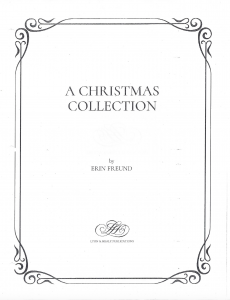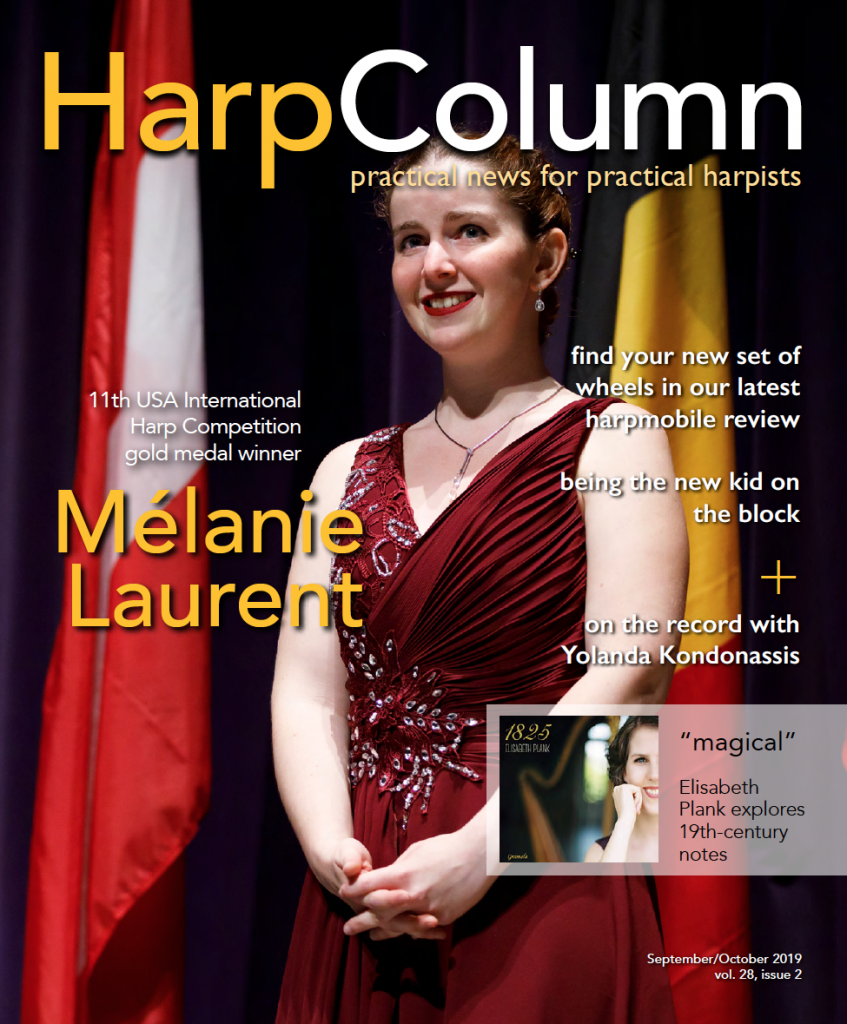It’s hard to believe it’s time to start planning for the holidays with record-breaking heat waves, but it is indeed time to start preparing. Fortunately, there are some intriguing new arrangements that should pique your interest and get you in a holiday mood.

Lyon & Healy Publications has published A Christmas Collection by Erin Freund for pedal harp. There are six innovative arrangements in this downloadable collection. The first selection is a two-page version of “Auld Lang Syne” in the style of Carlos Salzedo’s “Tango.” This is a sight-readable arrangement (especially if you’ve ever played “Tango,”) and it’s fun to play! There are no pedal changes and barely any fingering because it isn’t necessary. While harpists will find this most amusing, most audiences should find this entertaining. Try this arrangement on your New Year’s revelers this year!
Ms. Freund’s wit remains intact as she presents “Jolly Old Saint Nicholas” in the style of Pachelbel’s “Canon.” What seems like an unlikely pairing is a clever combination, at first with a single note melody and later with the melody in thirds. It’s also in the traditional key of D for you purists out there. She includes at least eight of the variations of the canon interspersed between the melody of “Jolly Old Saint Nicholas.”
The longest offering is “Les Patineurs Valse” (“The Skater’s Waltz”) at 10 pages. It includes the introduction and three waltzes, plus the coda. There are several repeats with the option to skip over sections if you prefer. This is an unusual but familiar piece to include for a seasonal event and very appropriate for a winter gig.
Jazz fans will enjoy the pairing of “Noël Nouvelet” and “We Three Kings” in the style of Dave Brubeck’s “Take Five.” It is in 5/4 with the familiar hook that is part of “Take Five.” The player is encouraged to repeat the hook as desired. All pedals are included below the staff.
Some fingering is provided on “Silent Night” in the style of Salzedo’s “Seguidilla.” Ms. Freund adroitly inserts the melody in the left hand between the ascending glisses. Unfortunately, it appears that the pedal changes were omitted on the third line of page 24. An F-natural, C-sharp, G-flat, and F-sharp need to be added to the music. You can hear where the pedals need to be changed.
The last selection is “The First Noel” in the style of J.S. Bach’s “Jesu, Joy of Man’s Desiring.” No fingering is suggested for this, but those who are comfortable playing this probably already have fingering that works. It’s a very pleasing combination.
The typesetting is easy to read and the music is not difficult for the upper intermediate to advanced player. With the exception of the omitted pedals in “Silent Night,” all pedal changes are notated. Some page turns are awkward, but not insurmountable. You can hear most of these selections on her website. This is a very appealing collection that showcases Freund’s considerable talent as an arranger. For something different and witty, try A Christmas Collection.

Frank Voltz (Chiera Music) is a wonderful source for Christmas music, and he has a couple of traditional Christmas carols that he has recently arranged for pedal harp. He begins his arrangement of “What Child Is This” with graceful, gushing arpeggios. The first verse features gorgeous jazz harmonies that are a treat for the ear. More arpeggios follow in the second verse. The final verse is a jazz waltz tempo with another arpeggio for good measure.
There is a page of performance notes at the beginning of the piece. Mr. Voltz helps the player to analyze the arpeggios and realize that they are cookie cutters, making them much easier to manage. He suggests you play it in E-flat minor for a more lush sound. The final, jazzy arpeggio is like a succulent caramel that explodes with flavor when you sink your teeth into it. Enjoy it!
Some fingering is suggested and all pedal changes are below the staff. The four page turns are manageable. You can hear this arrangement on his “Noel Nouveau” CD.

Mr. Voltz has also arranged “O Come, O Come Emmanuel” for lever or pedal harp. He maintains the modal feel of the original tune while trying to create a mysterious mood. He uses a rhythmically syncopated harmony to accompany the melody.
The second verse features triplets with a low bass note that rings through several measures. There are two slow scale glisses followed by arpeggios. He repeats the last phrase of the verse for an echo effect. The rhythmic accompaniment is reintroduced at the end. The final chord is E- major (with a G-sharp) instead of E-minor, and that requires the only pedal or lever change in the entire piece.
Fingering is kept to a minimum, and it really isn’t necessary. There are just two page turns, and the typesetting is easy to read. These pieces should be readily playable by an intermediate level player and make a nice addition to the Christmas repertoire. •
Jan Jennings is the music review editor for Harp Column and is the author of The Harpist’s Complete Wedding Guidebook and Effortless Glissing. Email her at mail@harpbiz.com.






